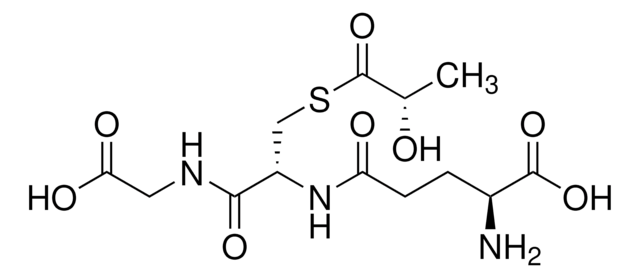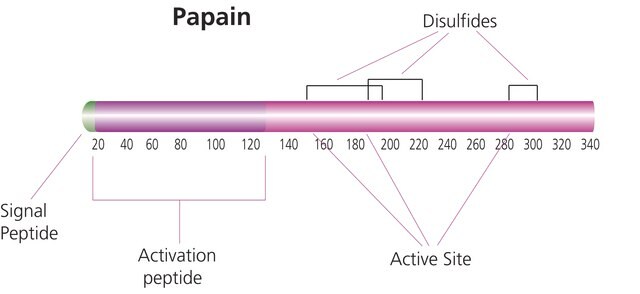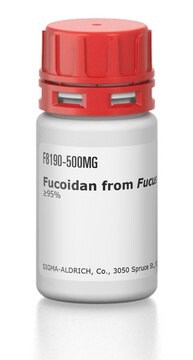Alle Fotos(1)
Wichtige Dokumente
G4252
Glyoxalase I from Saccharomyces cerevisiae
Grade IV, buffered aqueous glycerol solution, ≥400 units/mg protein
Synonym(e):
S-Lactoyl-glutathione methylglyoxal-lyase (isomerizing)
Anmeldenzur Ansicht organisationsspezifischer und vertraglich vereinbarter Preise
Alle Fotos(1)
About This Item
CAS-Nummer:
MDL-Nummer:
UNSPSC-Code:
12352204
NACRES:
NA.54
Empfohlene Produkte
Typ
Grade IV
Qualitätsniveau
Form
buffered aqueous glycerol solution
Spezifische Aktivität
≥400 units/mg protein
Fremdaktivität
glyoxalase II ≤1%
Lagertemp.
2-8°C
Suchen Sie nach ähnlichen Produkten? Aufrufen Leitfaden zum Produktvergleich
Allgemeine Beschreibung
Glyoxalase detoxification system consists of glyoxalase (GLO)-I and GLO-II. GLO-I is a cytosolic, 42 kDa, dimeric Zn2+ metalloenzyme.
Anwendung
Glyoxalase I from Saccharomyces cerevisiae has been used as a standard in Glyoxalase I assay for C. dilatata females and brooded encapsulated embryos. It has also been used as a standard for calibration curve generation for quantifying glyoxalase I from brain tissues and cerebral microvessels.
Biochem./physiol. Wirkung
Glyoxalase I is universally expressed and involved in the protection against cellular damage due to cytotoxic metabolites such as advanced glycation end products (AGEs). It is an integral component of the detoxification system, catalyzing the conversion of reactive, acyclic a-oxoaldehydes into the corresponding a-hydroxyacids in a glutathione-dependent manner.
Einheitendefinition
One unit will form 1.0 μmole of S-lactoylglutathione from methylglyoxal and reduced glutathione per min at pH 6.6 at 25 °C.
Physikalische Form
Solution in 50% glycerol, 0.4 M (NH4)2SO4 and 0.002 M KH2PO4 pH 6.5
Hinweis zur Analyse
Protein determined by biuret.
Lagerklassenschlüssel
10 - Combustible liquids
WGK
WGK 3
Flammpunkt (°F)
Not applicable
Flammpunkt (°C)
Not applicable
Persönliche Schutzausrüstung
Eyeshields, Gloves, multi-purpose combination respirator cartridge (US)
Hier finden Sie alle aktuellen Versionen:
Besitzen Sie dieses Produkt bereits?
In der Dokumentenbibliothek finden Sie die Dokumentation zu den Produkten, die Sie kürzlich erworben haben.
Kunden haben sich ebenfalls angesehen
Hiroya Taniguchi et al.
Molecular cancer therapeutics, 11(10), 2294-2300 (2012-07-13)
Methylglyoxal is an essential component in glycolysis and is known to be an inducer of apoptosis. Glyoxalase I (GLO1) metabolizes and inactivates methylglyoxal. GLO1 is known to be overexpressed in cancer cells and causes resistance to anticancer agents. We show
Metformin sensitizes endometrial cancer cells to chemotherapy by repressing glyoxalase I expression.
Lingling Dong et al.
The journal of obstetrics and gynaecology research, 38(8), 1077-1085 (2012-05-01)
Metformin plays an important role in the inhibition of cancer cell growth and prolongs remission durations. It reverses progestin-resistance in endometrial cancer cells by downregulating glyoxalase I (GloI) expression. This study aimed to investigate the effect of metformin on endometrial
Yufeng Wang et al.
Anticancer research, 32(8), 3219-3222 (2012-07-31)
Glyoxalase I (GLO1), an enzyme involved in the detoxification of methylglyoxal in the glycolysis pathway, has been found to be frequently overexpressed in various types of cancer. Recent studies showed that GLO1 is related to proliferation and apoptosis in human
Ravi Gupta et al.
Journal of proteome research, 11(5), 2684-2696 (2012-04-11)
Plants' distribution and productivity are adversely affected by low temperature (LT) stress. LT induced proteins were analyzed by 2-DE-nano-LC-MS/MS in shoot secretome of Hippophae rhamnoides (seabuckthorn), a Himalayan wonder shrub. Seedlings were subjected to direct freezing stress (-5 °C), cold
Miriam Urscher et al.
The FEBS journal, 279(14), 2568-2578 (2012-05-23)
Glucose consumption and therefore methylglyoxal production of human erythrocytes increase significantly upon infection with malaria parasites. The glyoxalase systems of the host-parasite unit cope with this metabolic challenge by catalyzing the removal of harmful methylglyoxal. Thus, glyoxalase 1 from the
Unser Team von Wissenschaftlern verfügt über Erfahrung in allen Forschungsbereichen einschließlich Life Science, Materialwissenschaften, chemischer Synthese, Chromatographie, Analytik und vielen mehr..
Setzen Sie sich mit dem technischen Dienst in Verbindung.
















